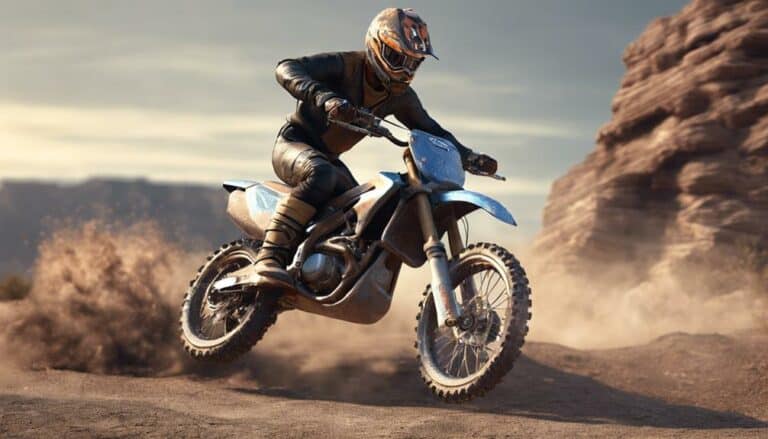Imagine your body on the bike is like a finely tuned instrument in an orchestra—each movement affecting the harmony of your off-road ride.
But how exactly can body positioning be your secret weapon for mastering stability and control in challenging terrains?
Let's explore the subtle yet powerful adjustments that can make a world of difference in your off-road riding experience.
Key Takeaways
- Balanced body position enhances stability and control on varied terrain.
- Proper weight distribution between wheels improves traction and maneuverability.
- Utilize weight shifting techniques for quick responses and better handling.
- Strategic body positioning optimizes bike control, comfort, and overall riding experience.
Importance of Proper Body Positioning
Proper body positioning in off-road riding greatly enhances rider comfort, confidence, and safety. When it comes to off-road adventures, your body plays a vital role in maintaining control and stability. By shifting your weight appropriately, you can effectively manage your center of gravity, which is key to maximizing traction and stability on diverse terrains. Ensuring that your riding position allows for proper body weight shifting enables you to maneuver through obstacles with ease while keeping your balance intact.
Standing up on the bike while riding not only enhances your visibility and shock absorption but also improves your overall control and maneuverability. By adjusting your body position to distribute weight effectively, you can navigate through challenging trails with confidence. Keeping your body centered and balanced on the bike enables you to respond to changing terrain conditions swiftly.
Key Principles for Off-Road Riding
To excel in off-road riding, mastering key principles that govern body positioning is fundamental for maintaining stability and control over diverse terrains.
- Balanced Body Position: Keeping a balanced position over changing terrain is essential for stability and control while managing obstacles.
- Proper Weight Distribution: Achieving stability and maneuverability on challenging trails requires correct weight distribution between the front and rear wheels.
- Adjusting Weight Shift: Shifting weight back during descents and forward during climbs enhances stability and control over varying terrains.
- Utilizing Body Positioning Techniques: Techniques such as dropping heels, bending arms and legs, and adjusting hip position help improve stability and response to obstacles.
Mastering these key principles will allow you to confidently tackle different terrain features, ensuring a smoother and more controlled off-road riding experience.
Techniques for Enhanced Stability
Enhancing stability in off-road riding involves employing specific techniques that optimize body positioning and weight distribution for improved control over challenging terrain. To enhance stability, focus on shifting your weight between the front and rear wheels to control the bike's pivot point and maintain control.
Keep your body weight forward to guarantee the rear wheel from slipping out and to ensure better traction on uneven surfaces. Drop your heels to lower your center of gravity and improve balance. Bend your knees and elbows to act as natural shock absorbers, smoothing out impacts and enhancing stability.
Utilize your arms and legs to absorb the terrain's irregularities, maintaining control over the bike. By maintaining a high body position, you can better distribute your weight and improve stability while riding off-road. Remember to lower your chest and keep your head up for increased balance and visibility, allowing you to navigate challenging terrain with confidence and control.
Control Strategies for Off-Road Terrain
When exploring off-road terrain, mastering control strategies is important for optimizing stability and maneuverability on challenging trails. To stay in control and get through effectively, consider the following key techniques:
- Shift Your Weight: When riding downhill or encountering changes in terrain, shift your weight towards the rear of the bike to maintain traction and stability.
- Body Forward: Keep your body forward when dealing with obstacles or rough terrain to prevent the front wheel from lifting and losing traction.
- Weight to the Outside: When cornering or handling tight turns, shift your weight to the outside of the bike to counterbalance and maintain control.
- Balls of Your Feet: Always keep the balls of your feet on the footpegs to allow for quick weight adjustments and better absorption of impacts.
Implementing Advanced Body Positioning
Implementing advanced body positioning techniques requires maintaining a dynamic center of mass to effectively adapt to the ever-changing terrain features encountered during off-road riding. When riding a mountain bike off-road, it's important to shift your body mass strategically between the front and rear of the bike to optimize weight distribution. Keeping your hands light on the handlebars allows for better control and maneuverability, reducing the risk of being thrown off balance on rough terrain. By mastering the art of weight shifting, you can enhance stability and control, enabling smoother navigation through challenging trails.
Additionally, balancing your body's weight distribution not only improves stability but also enhances the bike's responsiveness to your commands. This dynamic adjustment of weight plays a key role in optimizing the suspension system's performance, aiding in absorbing impacts and maintaining traction. Through consistent practice and refinement of advanced body positioning techniques, you can achieve greater efficiency in energy transfer and overall handling capabilities during off-road riding adventures.
Conclusion
To sum up, mastering proper body positioning is essential for enhancing stability and control during off-road riding. By following key principles and techniques, riders can optimize their weight distribution, balance, and reaction time on challenging terrains.
Remember, like a well-tuned instrument, your body is your key to exploring the twists and turns of off-road trails with precision and confidence. Keep refining your body positioning skills to elevate your off-road riding experience to new heights.

